Climate Change and the Caribbean: Challenges and Vulnerabilities in Building Resilience to Tropical Cyclones
Abstract
1. Introduction
2. Materials and Methods
- Firstly, the disaster list was selected from the database search options.
- Secondly, the period from 1980 to 2019 was inputted.
- Thirdly, the geographical region was selected as well as choosing the 19 individual countries.
- Fourthly, the disaster type (meteorological) and total damage and loss were selected. By clicking the search button, the data was generated.
3. Results
3.1. Quantitative Analysis
3.2. Qualitative Analysis
4. Discussion
4.1. The Inherent Disadvantage of Caribbean SIDS Income Status Classification and High Public Debts
4.2. Need for Increased Access to Adaptation Financing for SIDS
4.3. Need for Increased EWS
5. Conclusions
Funding
Data Availability Statement
Acknowledgments
Conflicts of Interest
References
- Nurse, L.A.; McLean, R.F.; Agard, J.; Briguglio, L.P.; Duvat-Magnan, V.; Pelesikoti, N.; Tompkins, E.; Webb, A. Small islands. In Climate Change 2014: Impacts, Adaptation, and Vulnerability. Part B: Regional Aspects; Barros, V.R., Field, C.B., Dokken, D.J., Mastrandrea, M.D., Mach, K.J., Bilir, T.E., Chatterjee, M., Ebi, K.L., Estrada, Y.O., Genova, R.C., et al., Eds.; Cambridge University Press: Cambridge, UK; New York, NY, USA, 2014; pp. 1613–1654. Available online: https://www.ipcc.ch/site/assets/uploads/2018/02/WGIIAR5-Chap29_FINAL.pdf (accessed on 20 December 2021).
- Nunn, P.D. The end of the Pacific? Effects of sea level rise on Pacific Island livelihoods. Singap. J. Trop. Geogr. 2013, 34, 143–171. [Google Scholar] [CrossRef]
- Mycoo, M.A. Beyond 1.5 °C: Vulnerabilities and adaptation strategies for Caribbean Small Island Developing States. Reg. Environ. Change 2017, 18, 2341–2353. [Google Scholar] [CrossRef]
- IPCC. Annex II: Glossary. In Climate Change 2014: Impacts, Adaptation, and Vulnerability. Part B: Regional Aspects. Con-tribution of Working Group II to the Fifth Assessment Report of the Intergovernmental Panel on Climate Change; Barros, V.R., Field, C.B., Dokken, D.J., Mastrandrea, M.D., Mach, K.J., Bilir, T.E., Chatterjee, M., Ebi, K.L., Estrada, Y.O., Genova, R.C., et al., Eds.; Cambridge University Press: Cambridge, UK; New York, NY, USA, 2014; pp. 1757–1776. [Google Scholar]
- Mimura, N.; Nurse, L.; McLean, R.F.; Agard, J.; Briguglio, L.; Lefale, P.; Payet, R.; Sem, G. Small islands. In Climate Change 2007: Impacts, Adaptation and Vulnerability; Parry, M.L., Canziani, O.F., Palutikof, J.P., van der Linden, P.J., Hanson, C.E., Eds.; Cambridge University Press: Cambridge, UK; New York, NY, USA, 2007; pp. 687–716. Available online: https://www.ipcc.ch/site/assets/uploads/2018/03/ar4_wg2_full_report.pdf (accessed on 20 December 2021).
- Wilkinson, E.; Twigg, J.; Few, R. Building back Better: A Resilient Caribbean after the 2017 Hurricanes; Overseas Development Institute (ODI): London, UK, 2018; Available online: https://cdn.odi.org/media/documents/12028.pdf (accessed on 12 January 2022).
- Robinson, S.-A. Climate change adaptation trends in small island developing states. Mitig. Adapt. Strat. Glob. Change 2015, 22, 669–691. [Google Scholar] [CrossRef]
- Parry, M.; Arnell, N.; Berry, P.; Dodman, D.; Fankhauser, S.; Hope, C.; Kovats, S.; Nicholls, R.; Satterthwaite, D.; Tiffin, R.; et al. Assessing the Costs of Adaptation to Climate Change: A Review of the UNFCCC and Other Recent Estimates; International Institute for Environment and Development and Grantham Institute for Climate Change: London, UK, 2009. [Google Scholar]
- Morita, K. Financing climate change adaptation in small island developing states. IOP Conf. Series: Earth Environ. Sci. 2009, 6. [Google Scholar] [CrossRef]
- Osbahr, H. Building Resilience: Adaptation Mechanisms and Mainstreaming for the Poor; Human Development Report Office Occasional Paper, United Nations Development Programme: New York, NY, USA, 2007; Available online: http://hdr.undp.org/sites/default/files/osbahr_henny.pdf (accessed on 12 January 2022).
- Hay, J.E. Small island developing states: Coastal systems, global change and sustainability. Sustain. Sci. 2013, 8, 309–326. [Google Scholar] [CrossRef]
- Cardona, O.D.; Van Aalst, M.K.; Birkmann, J.; Fordham, M.; Mc Gregor, G.; Rosa, P.; Pulwarty, R.S.; Schipper, E.L.F.; Sinh, B.T.; Décamps, H. Determinants of risk: Exposure and vulnerability. In Managing the Risks of Extreme Events and Disasters to Advance Climate Change Adaptation: Special Report of the Intergovernmental Panel on Climate Change; Cambridge University Press: Cambridge, UK, 2012; pp. 65–108. [Google Scholar]
- Béné, C.; Newsham, A.; Davies, M.; Ulrichs, M.; Godfrey-Wood, R. Review Article: Resilience, Poverty and Development. J. Int. Dev. 2014, 26, 598–623. [Google Scholar] [CrossRef]
- UN. The International Year of Small Island Developing States. 2014. Available online: http://www.un.org/en/events/islands2014 (accessed on 12 January 2022).
- Pielke, R.A.; Rubiera, J.; Landsea, C.; Fernández, M.L.; Klein, R. Hurricane Vulnerability in Latin America and The Caribbean: Normalized Damage and Loss Potentials. Nat. Hazards Rev. 2003, 4, 101–114. [Google Scholar] [CrossRef]
- UNTWO. Climate Change and Tourism: Responding to Global Challenges; World Tourism Organization and the United Nations Environment Programme, Paris; France UNTWO: Madrid, Spain, 2008; Available online: https://www.e-unwto.org/doi/pdf/10.18111/9789284412341 (accessed on 8 February 2022).
- Birkmann, J.; Cardona, O.D.; Carreño, M.L.; Barbat, A.H.; Pelling, M.; Schneiderbauer, S.; Kienberger, S.; Keiler, M.; Alexander, D.; Zeil, P.; et al. Framing vulnerability, risk and societal responses: The MOVE framework. Nat. Hazards 2013, 67, 193–211. [Google Scholar] [CrossRef]
- Füssel, H.-M.; Klein, R.J. Climate Change Vulnerability Assessments: An Evolution of Conceptual Thinking. Clim. Change 2006, 75, 301–329. [Google Scholar] [CrossRef]
- Betzold, C. Adapting to climate change in small island developing states. Clim. Change 2015, 133, 481–489. [Google Scholar] [CrossRef]
- Ghina, F. Sustainable Development in Small Island Developing States. Environ. Dev. Sustain. 2003, 5, 139–165. [Google Scholar] [CrossRef]
- Kelman, I. No change from climate change: Vulnerability and small island developing states. Geogr. J. 2013, 180, 120–129. [Google Scholar] [CrossRef]
- Alexander, J.M.; Kueffer, C.; Daehler, C.; Edwards, P.J.; Pauchard, A.; Seipel, T.; Arévalo, R.J.; Cavieres, L.A.; Dietz, H.; Jakobs, G.; et al. Assembly of nonnative floras along elevational gradients explained by directional ecological filtering. Proc. Natl. Acad. Sci. USA 2011, 108, 656–661. [Google Scholar] [CrossRef] [PubMed]
- Deidda, M. Insularity and economic development: A survey. Int. Rev. Econ. 2015, 63, 107–128. [Google Scholar] [CrossRef]
- UN DESA. Trends in Sustainable Development: Small Island Developing States (SIDS); United Nation. UN DESA: New York, NY, USA, 2010; Available online: https://sustainabledevelopment.un.org/content/documents/313Trends_in_Sustainable_Development_SIDS.pdf (accessed on 8 February 2022).
- Fernandes, R.; Pinho, P. The distinctive nature of spatial development on small islands. Prog. Plan. 2017, 112, 1–18. [Google Scholar] [CrossRef]
- Nunn, P. Responding to the challenges of climate change in the Pacific Islands: Management and technological imperatives. Clim. Res. 2009, 40, 211–231. [Google Scholar] [CrossRef]
- Kuruppu, N.; Willie, R. Barriers to reducing climate enhanced disaster risks in Least Developed Country-Small Islands through anticipatory adaptation. Weather Clim. Extremes 2015, 7, 72–83. [Google Scholar] [CrossRef]
- United Nations (UN). The Future We Want; Agenda 21; United Nations (UN): Rio de Janeiro, Brazil.
- Mycoo, M.; Donovan, M.G. A Blue Urban Agenda: Adapting to Climate Change in the Coastal Cities of Caribbean and Pacific Small Island Developing States; Inter-American Development Bank: Washington DC, USA, 2017. [Google Scholar] [CrossRef]
- UNEP. Emerging Issues for Small Island Developing States. Results of the UNEP/UN DESA Foresight Process; UNEP: Nairobi, Kenya, 2014; Available online: http://www.sustainablesids.org/knowledgebase/unep-emerging-issues-for-small-island-developing-states-results-of-the-unep-foresight-process-2014 (accessed on 8 September 2021).
- Barr, R.; Fankhauser, S.; Hamilton, K. Adaptation investments: A resource allocation framework. Mitig. Adapt. Strat. Glob. Change 2010, 15, 843–858. [Google Scholar] [CrossRef]
- Bueno, R.; Herzfeld, C.; Santon, E.A.; Ackerman, F. The Caribbean and Climate Change: The Costs of Inaction; Stockholm Environmental Institute: Sweden, Stockholm, 2008. [Google Scholar]
- Mendelsohn, R.; Emanuel, K.; Chonabayashi, S.; Bakkensen, L. The impact of climate change on global tropical cyclone damage. Nat. Clim. Change 2012, 2, 205–209. Available online: http://www.nature.com/doifinder/10.1038/nclimate1357 (accessed on 15 November 2021). [CrossRef]
- Eisenhardt, K.M.; Graebner, M.E. Theory Building from Cases: Opportunities and Challenges. Acad. Manag. J. 2007, 50, 25–32. [Google Scholar] [CrossRef]
- Meinzen-Dick, R. Beyond panaceas in water institutions. Proc. Natl. Acad. Sci. USA 2007, 104, 15200–15205. [Google Scholar] [CrossRef] [PubMed]
- Poteete, A.R.; Janssen, M.A.; Ostrom, E. Working Together: Collective Action, the Commons, and Multiple Methods in Practice; Princeton University Press: Princeton, NJ, USA, 2010. [Google Scholar]
- World Bank. Middle Income Countries Overview; World Bank: Washington, DC, USA, 2018; Available online: https://www.worldbank.org/en/country/mic/overview (accessed on 15 September 2021).
- Hurley, G. Building back Better Requires Supportive International Finance; 2017. Available online: https://blogs.lse.ac.uk/latamcaribbean/2017/11/01/building-back-better-in-the-caribbean-requires-supportive-international-finance/ (accessed on 20 March 2022).
- World Bank. A 360 Degree Look at Dominica Post Hurricane Maria; World Bank: Washington, DC, USA, 2017; Available online: http://www.worldbank.org/en/news/feature/2017/11/28/a-360-degree-look-at-dominica-post-hurricane-maria (accessed on 10 October 2021).
- IMF. Caribbean Small States: Challenges of High Debt and Low Growth; IMF: Washington, DC, USA, 2013; Available online: https://www.imf.org/external/np/pp/eng/2013/022013b.pdf (accessed on 21 September 2021).
- Bourne, C. Financing for Development Challenges in Caribbean SIDS: A Case for Review of Eligibility Criteria for Access to Concessional Financing; United Nations Development Programme: New York, NY, USA, 2015; Available online: http://www.undp.org/content/dam/rblac/docs/Research%20and%20Publications/Poverty%20Reduction/UNDP_RBLAC_Financing_for_Development_ReportCaribbean.pdf (accessed on 15 September 2021).
- Government of the Commonwealth of Dominica. Post-Disaster Needs Assessment: Hurricane Maria; Government of the Commonwealth of Dominica: Roseau, Dominica, 2017; Available online: https://reliefweb.int/sites/reliefweb.int/files/resources/dominica-pdna-maria.pdf (accessed on 18 September 2021).
- Inter-American Development Bank. 2019. Available online: https://www.iadb.org/en/news/damages-and-other-impacts-bahamas-hurricane-dorian-estimated-34-billion-report (accessed on 10 October 2021).
- AOSIS. AOSIS Opening Statement for 21st Conference of Parties to the UNFCCC; Alliance of Small Island States: Paris, France, 2015; Available online: http://aosis.org/wp-content/uploads/2015/12/FINAL-AOSIS-COPStatement-Paris-.pdf (accessed on 10 October 2021).
- World Bank. Economics of Adaptation to Climate Change—Synthesis Report; World Bank: Washington, DC, USA, 2010; Available online: http://documents.worldbank.org/curated/en/2010/01/16436675/economicsadaptation-climate-change-synthesis-report (accessed on 10 October 2021).
- Buchner, B.; Stadelmann, M.; Wilkinson, J.; Mazza, F.; Rosenberg, A.; Abramskiehn, D. The global Landscape of Climate Finance 2014, CPI Report; Climate Policy Initiative: Venice, Italy, 2014; Available online: http://climatepolicyinitiative.org/wp-content/uploads/2014/11/The-Global-Landscape-of-Climate-Finance-2014.pdf (accessed on 18 September 2021).
- NOAA. National Weather Service: Major Hurricane Maria. 2017. Available online: https://www.weather.gov/sju/maria2017 (accessed on 20 September 2017).
- National Hurricane Centre. Tropical Cyclone Report: Hurricane Maria. 2017. Available online: https://www.nhc.noaa.gov/data/tcr/AL152017_Maria.pdf (accessed on 10 October 2021).
- Caribbean: Lessons Learnt on Early Warning Systems Following the 2017 Hurricane. Available online: https://www.crews-initiative.org/en/projects/caribbean-lessons-learnt-early-warning-systems-following-2017-hurricane (accessed on 8 October 2021).
- Climate Centre. UN: In 5 Years, Everyone on Earth Must be Protected by Early Warning for Extreme Weather, Climate Change. Available online: https://www.climatecentre.org/8111/un-within-5-years-everyone-on-earth-must-be-protected-by-early-warningfor-increasingly-extreme-weather-and-climate-change/ (accessed on 18 September 2021).
- General Assembly of the United Nations. Saint Vincent and the Grenadines; General Assembly of the United Nations: New York, UY, USA, 2018; Available online: https://gadebate.un.org/en/73/saint-vincent-and-grenadines (accessed on 18 September 2021).
- Fankhauser, S. The costs of adaptation. WIREs Clim. Change 2009, 1, 23–30. [Google Scholar] [CrossRef]
- Ramkissoon, H.; Kahwa, I.A. UNESCO Science Report: Towards 2030. Available online: https://en.unesco.org/sites/default/files/usr15_caricom.pdf (accessed on 15 September 2021).
- Hallegatte, S. Strategies to adapt to an uncertain climate change. Glob. Environ. Change 2009, 19, 240–247. [Google Scholar] [CrossRef]
- Schipper, E.L.F. Meeting at the crossroads?: Exploring the linkages between climate change adaptation and disaster risk reduction. Clim. Dev. 2009, 1, 16–30. [Google Scholar] [CrossRef]
- Fankhauser, S.; Burton, I. Spending adaptation money wisely. Clim. Policy 2011, 11, 1037–1049. [Google Scholar] [CrossRef]
- Boruff, B.; Cutter, S. The Environmental Vulnerability of Caribbean Island Nations. Geogr. Rev. 2007, 97, 24–45. [Google Scholar] [CrossRef]
- Ferdinand, I.; O’Brien, G.; O’Keefe, P.; Jayawickrama, J. The double bind of poverty and community disaster risk reduction: A case study from the Caribbean. Int. J. Disaster Risk Reduct. 2012, 2, 84–94. [Google Scholar] [CrossRef]
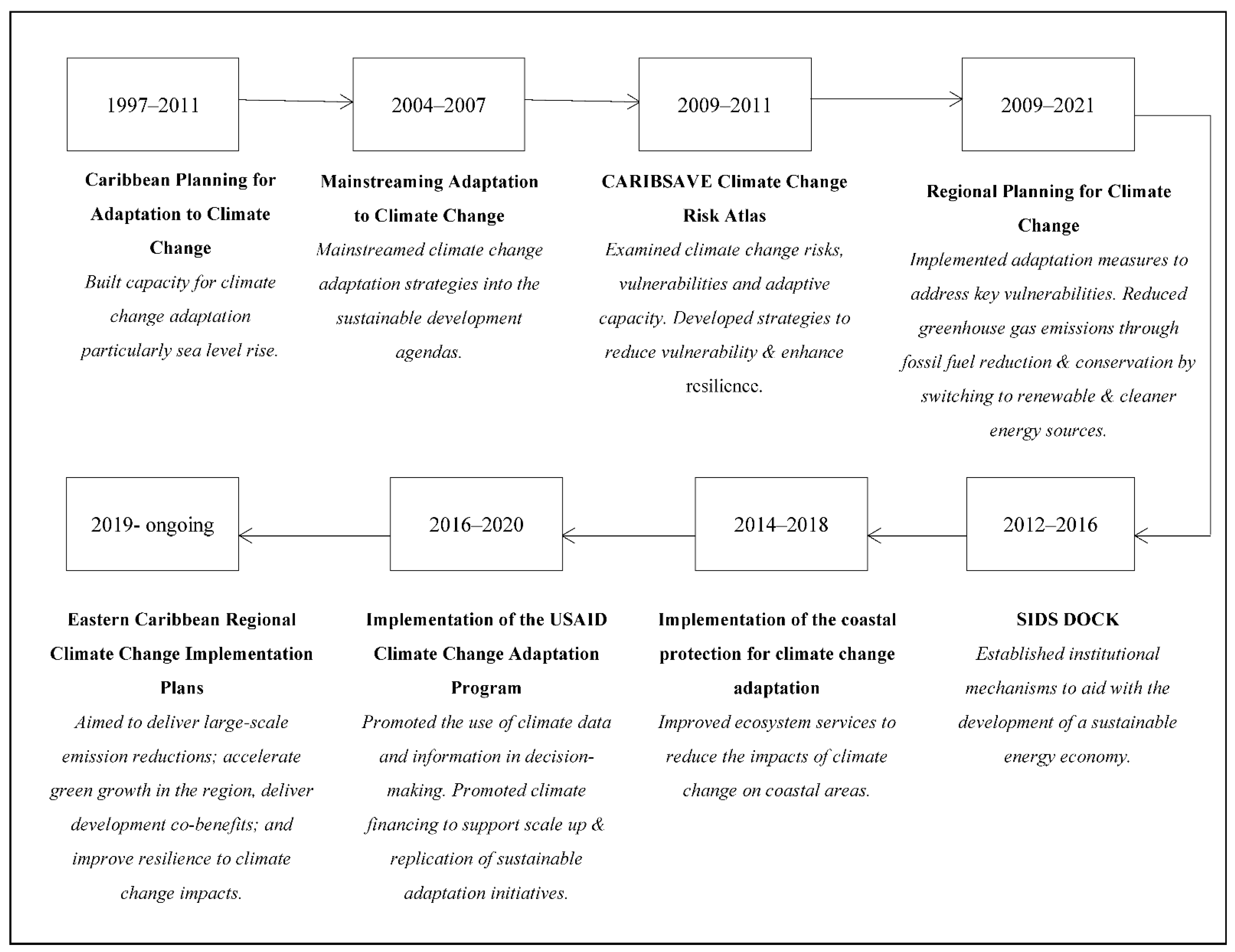
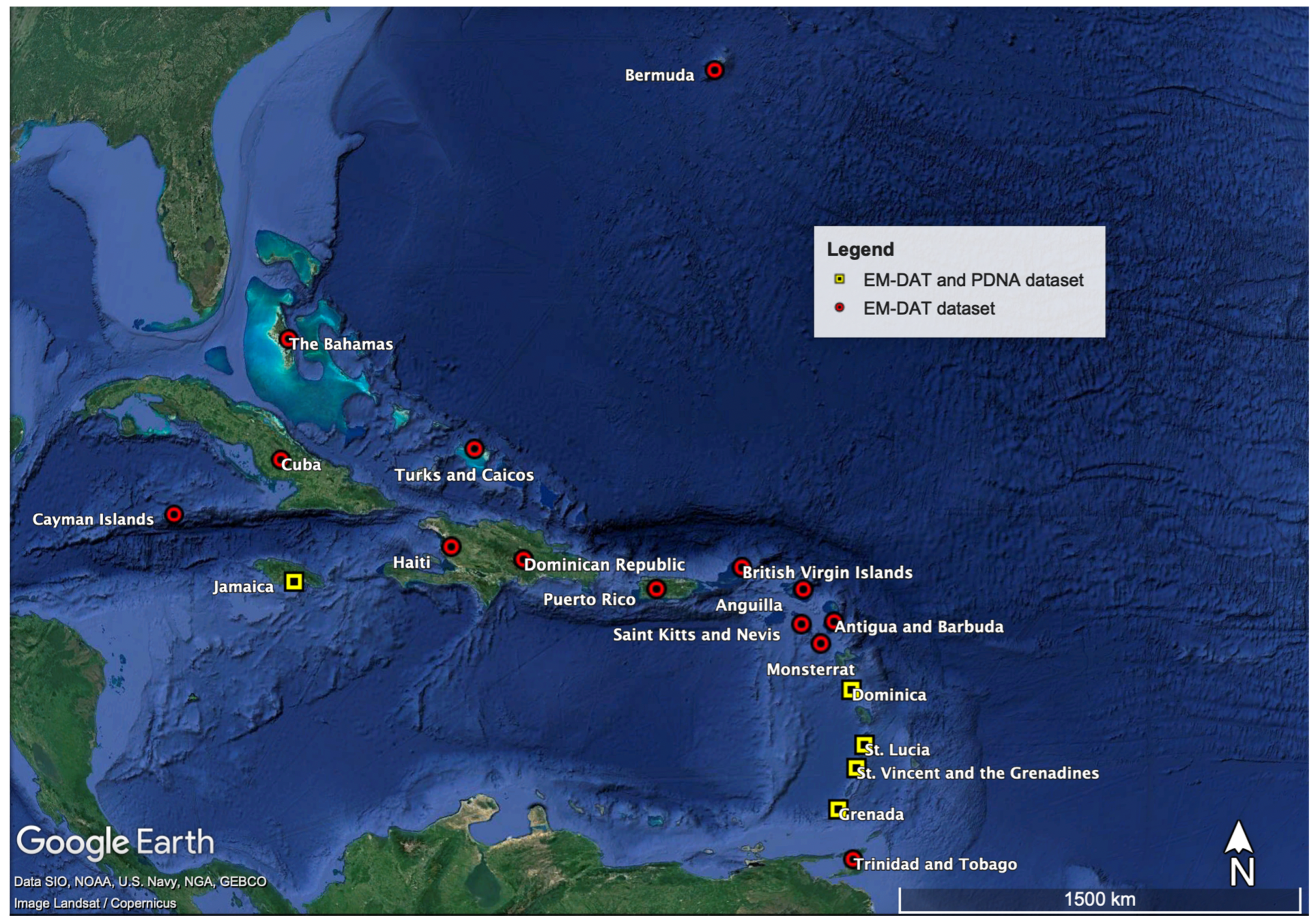
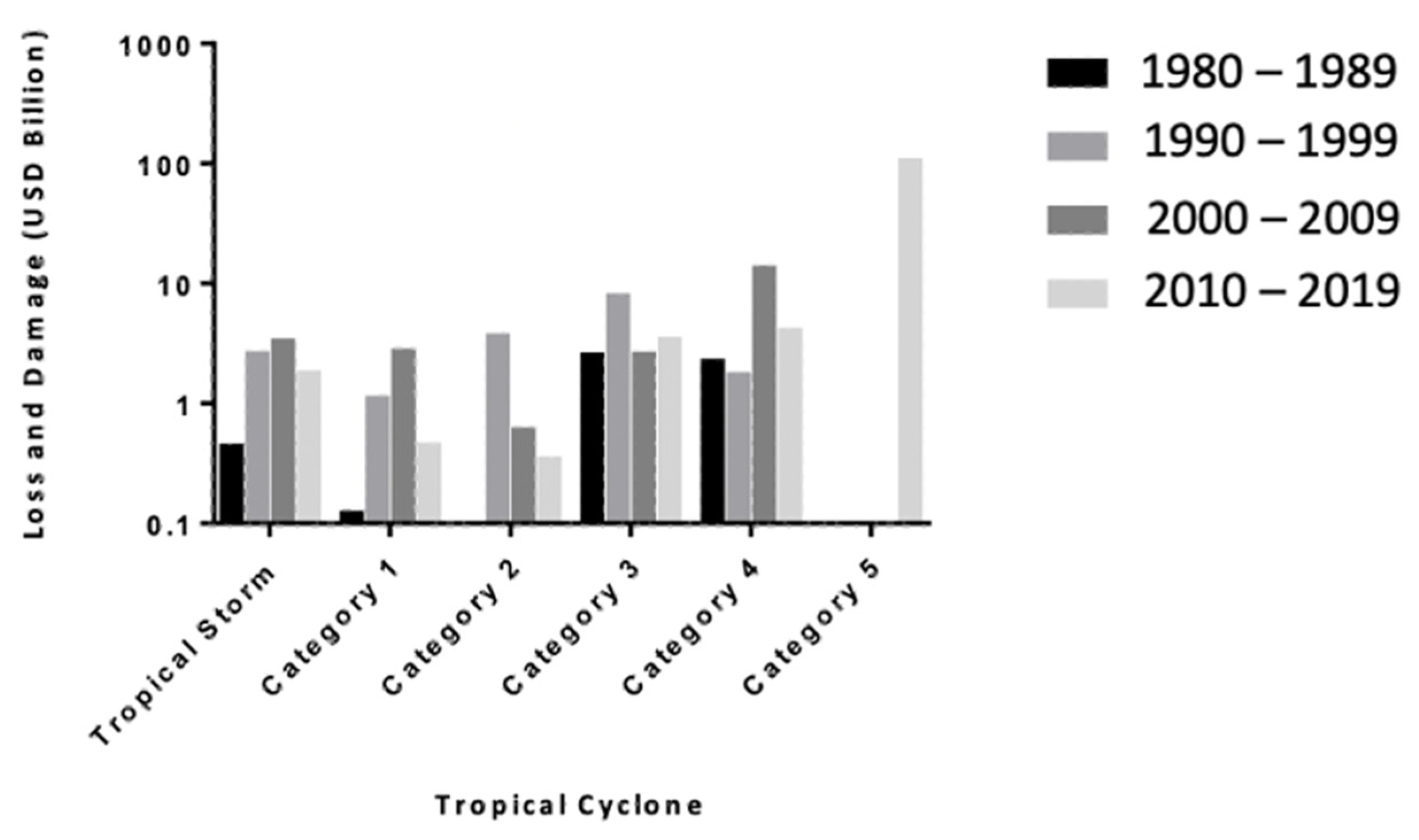
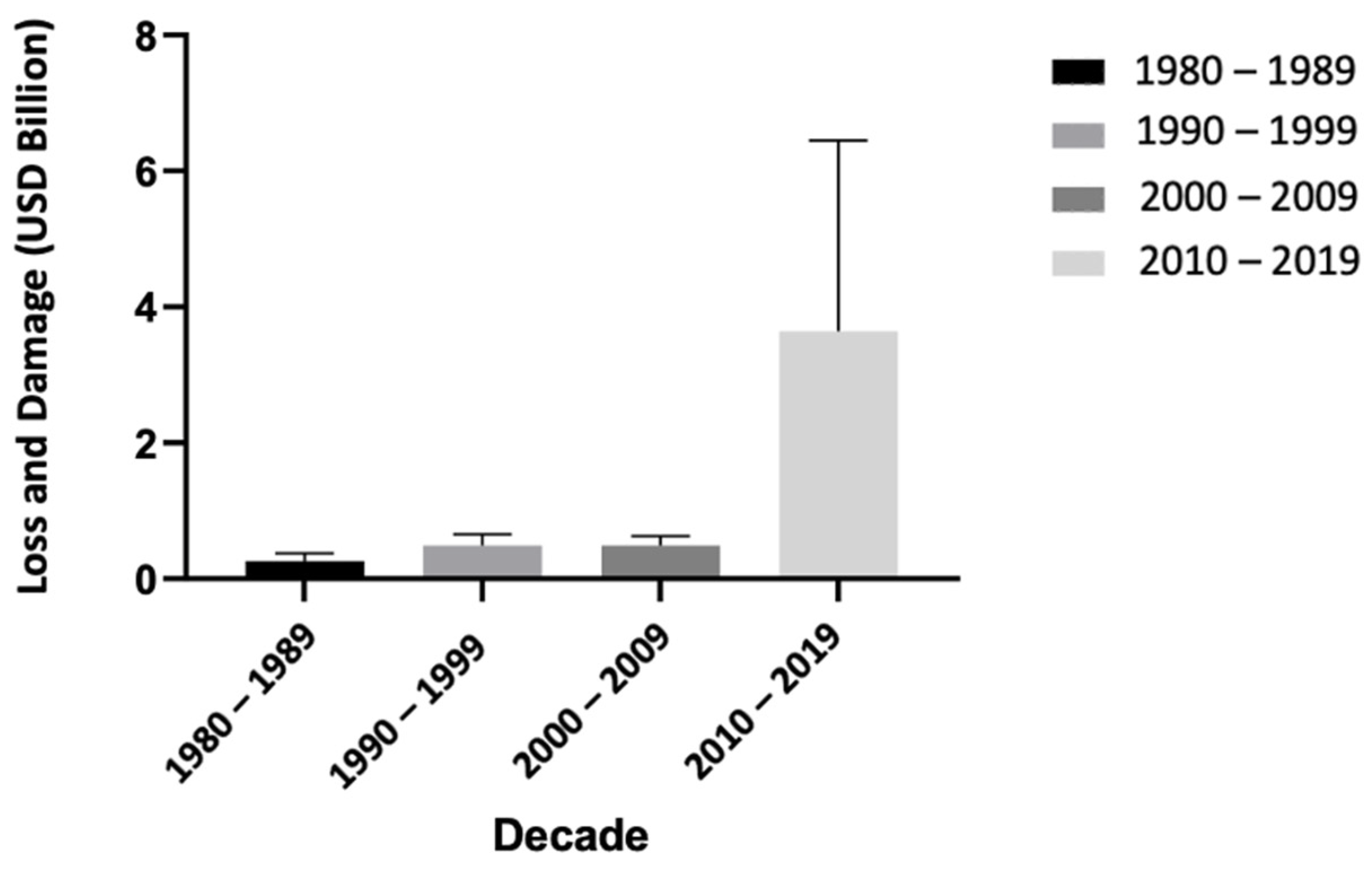
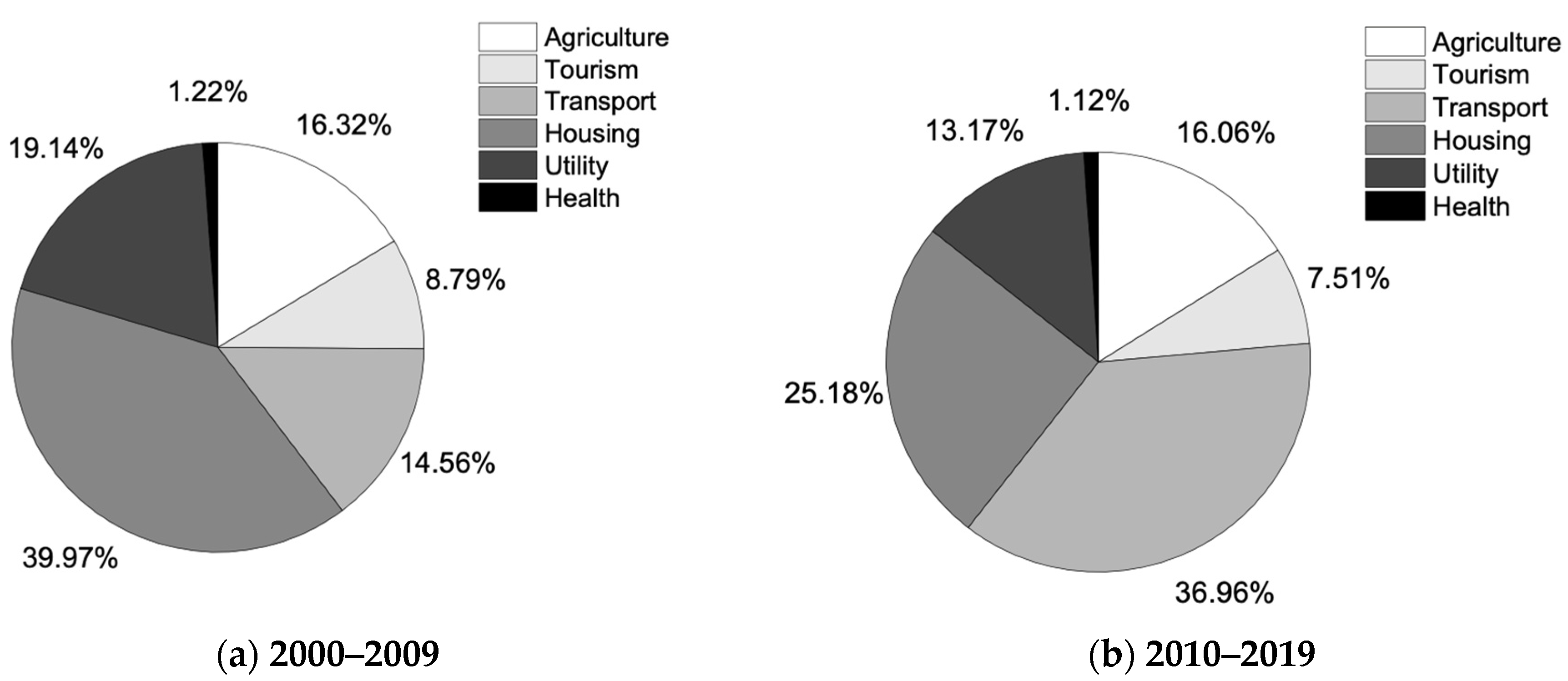
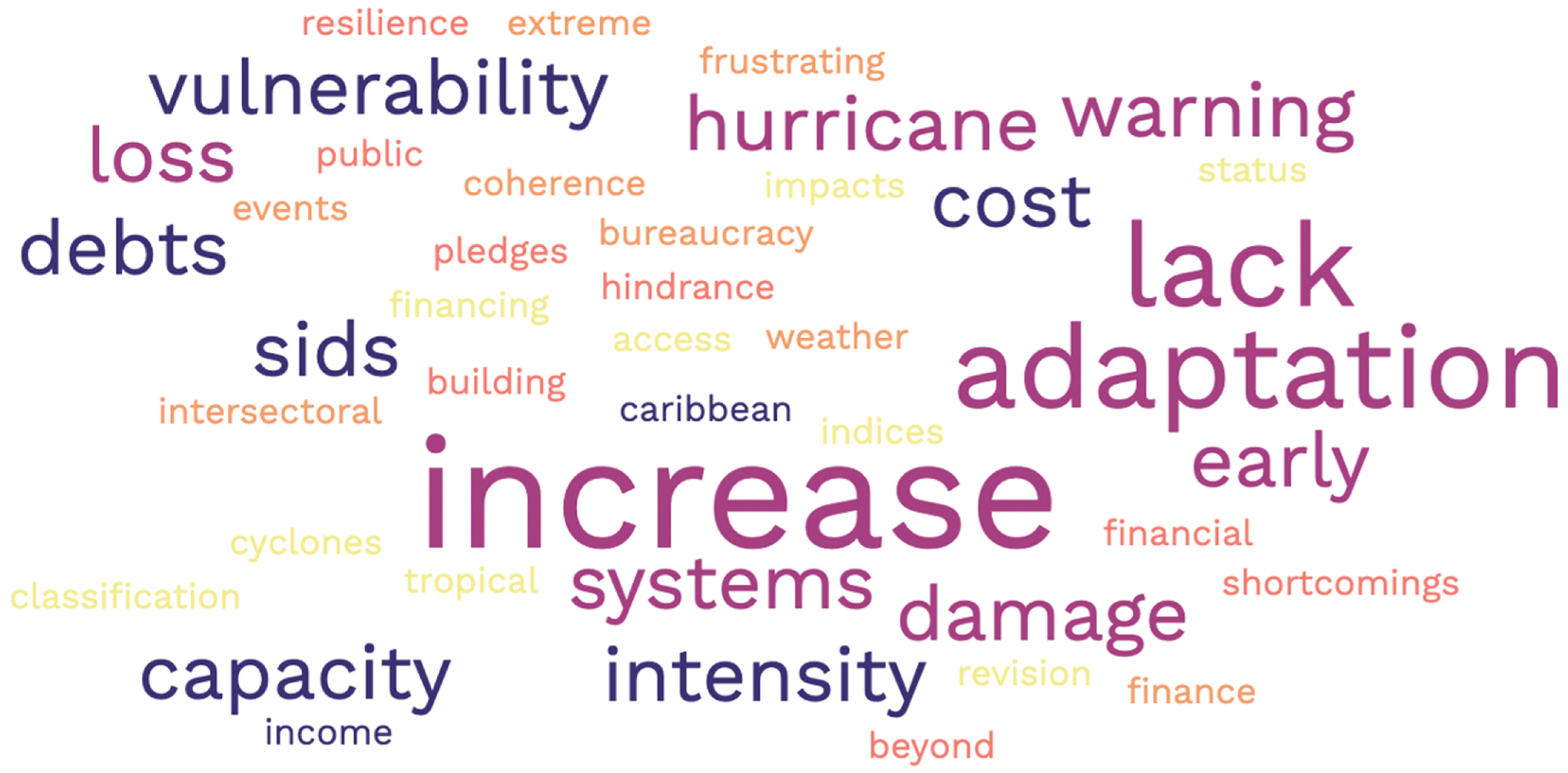
| Type of TC | Number of TC |
|---|---|
| Tropical Storm | 23 |
| Category 1 | 10 |
| Category 2 | 8 |
| Category 3 | 11 |
| Category 4 | 12 |
| Category 5 | 3 |
| Sectors Impacted by Tropical Cyclones | |||||||
|---|---|---|---|---|---|---|---|
| Agriculture | Tourism | Transport | Utility | Health | Housing | ||
| Potential damages and cascading effects | Increase in food security issues | ✓ | ✓ | ✓ | ✓ | ✓ | |
| Loss of livelihoods | ✓ | ✓ | ✓ | ✓ | |||
| Damage to transport facilities | ✓ | ✓ | ✓ | ✓ | ✓ | ✓ | |
| Water shortages | ✓ | ✓ | ✓ | ✓ | |||
| Increase water & mosquito borne diseases | ✓ | ✓ | ✓ | ✓ | |||
| Electricity & Telecommunication shortages | ✓ | ✓ | ✓ | ✓ | |||
| Loss in commercial agriculture | ✓ | ✓ | ✓ | ✓ | |||
| Decrease in foreign investments and revenues | ✓ | ✓ | ✓ | ✓ | ✓ | ||
| Damage to health facilities | ✓ | ✓ | ✓ | ✓ | |||
| Increase cost of living | ✓ | ✓ | ✓ | ✓ | |||
| Increase cost to rebuild and restore transport facilities | ✓ | ✓ | |||||
Publisher’s Note: MDPI stays neutral with regard to jurisdictional claims in published maps and institutional affiliations. |
© 2022 by the author. Licensee MDPI, Basel, Switzerland. This article is an open access article distributed under the terms and conditions of the Creative Commons Attribution (CC BY) license (https://creativecommons.org/licenses/by/4.0/).
Share and Cite
Lewis, C.T. Climate Change and the Caribbean: Challenges and Vulnerabilities in Building Resilience to Tropical Cyclones. Climate 2022, 10, 178. https://doi.org/10.3390/cli10110178
Lewis CT. Climate Change and the Caribbean: Challenges and Vulnerabilities in Building Resilience to Tropical Cyclones. Climate. 2022; 10(11):178. https://doi.org/10.3390/cli10110178
Chicago/Turabian StyleLewis, Clint T. 2022. "Climate Change and the Caribbean: Challenges and Vulnerabilities in Building Resilience to Tropical Cyclones" Climate 10, no. 11: 178. https://doi.org/10.3390/cli10110178
APA StyleLewis, C. T. (2022). Climate Change and the Caribbean: Challenges and Vulnerabilities in Building Resilience to Tropical Cyclones. Climate, 10(11), 178. https://doi.org/10.3390/cli10110178






